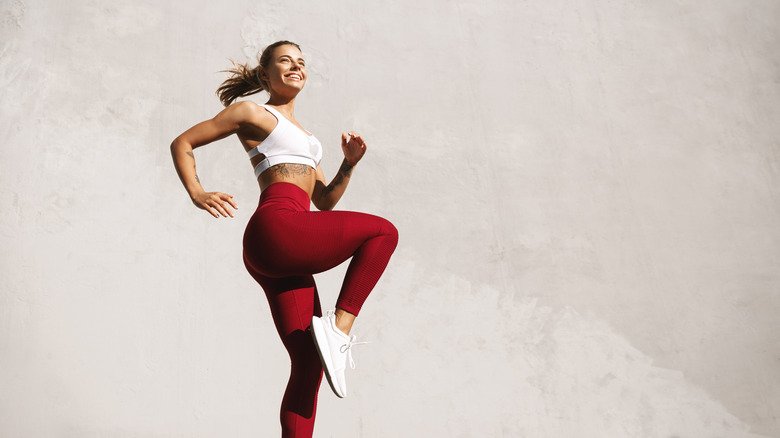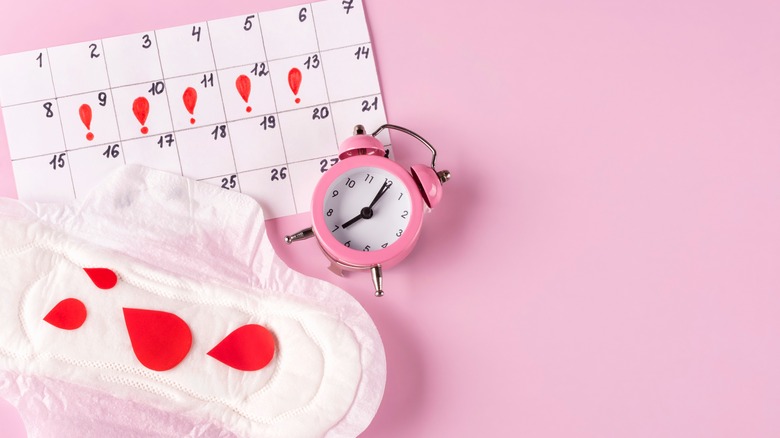How Your Period Could Inspire Your Workout Routine
Often, tiredness and loss of motivation hinder people from working out regularly. While lethargy is normal to experience from time to time, what if there's more behind the lack of energy that creeps up when it's time to hit the gym?
On average, the menstrual cycle is about 28 days, but it can last anywhere from 21 to 35 days, says Cleveland Clinic. For many people, they're experiencing upticks and declines in their energy levels and hormones for a month, every month. With internal changes occurring about every week, it's no wonder working out can feel like an impossible task for some.
Yet, exercising is a necessary evil that does a lot of good for one's overall health. Knowing this, it may be tempting to just fight through the feelings and push yourself to do a hard workout, even if you're not up to it. However, opting to work out based on your menstrual cycle rather than fighting against nature may help you crack the code to feel more motivated.
Energy levels increase and decrease throughout each phase
The menstrual cycle is split into four different phases, explains Clue. The first cycle is the uterine cycle, otherwise known as menstruation when the lining of the uterus is shed. Lasting anywhere from three to seven days, your levels of estrogen and progesterone are at their lowest, causing tiredness and lethargy.
While menstruation is ongoing, the follicular phase starts, typically on the first day of your period, lasting until ovulation begins. This is when the follicles in your ovaries develop at different paces. The largest follicle will be released during ovulation. Lasting for 10-22 days, hormone levels start to rise again, giving you more energy.
Roughly 14 days before your next period comes ovulation, when an egg from the biggest follicle is released, departing the ovary and entering the fallopian tube. Increased estrogen levels signal the brain to release the hormone that causes ovulation. At this stage of the cycle, your estrogen levels are at their highest, falling off after ovulation occurs.
The final part of the cycle, the luteal phase, starts from ovulation and lasts until your period starts. For nine to 16 days, the follicle transforms into a corpus luteum, creating estrogen and progesterone that help pregnancy. If there are no signs of pregnancy, it will break down within about ten days. Afterward, progesterone amounts will drop, causing PMS symptoms such as bloating and mood changes.
Align your exercises with your hormone levels
For workouts during menstruation, it's best to keep it light. Although exercising during your period may be the last thing you want to do, Verywell Fit reports that it may help to reduce your pain and discomfort. With your energy at its lowest, low-impact workouts such as walking, yoga, or light Pilates can help to strengthen you a bit.
Women's Fitness recommends pushing yourself during the follicular phase, opting for more high-intensity exercises. At this stage, testosterone levels are higher, increasing your muscle strength gains and energy levels. Estrogen also rises during this phase, so its anti-inflammatory properties can help with pain endurance.
Energy levels during ovulation are similar to the follicular phase. With estrogen levels at their highest, continuing high-impact exercises such as running, kickboxing, or strength training is encouraged. If you're trying to get pregnant during ovulation, Clear Blue says to switch to more moderate exercises like swimming, hiking, or strength training using light weights only.
For the luteal phase, progesterone levels drop, taking your energy with it. It's best to focus on light exercises and recovery during this two-week period. While things like walking, yoga, or Pilates are encouraged, conserving your energy is also essential. If you choose to exercise, stay away from hot environments that may cause you to get tired quickly.


